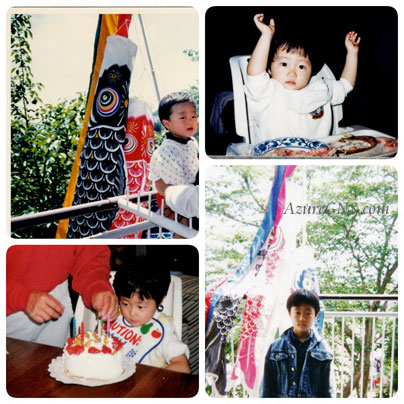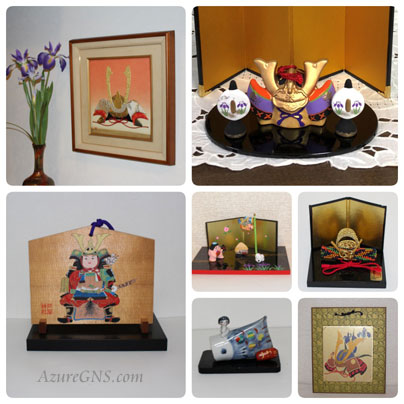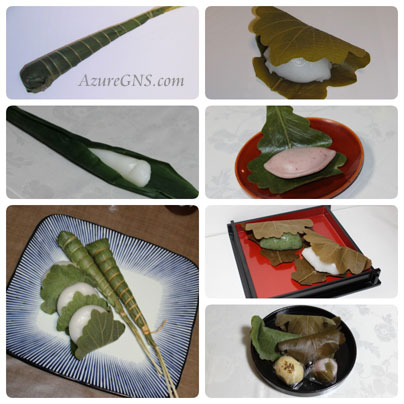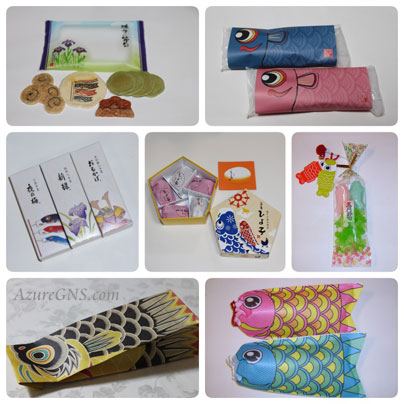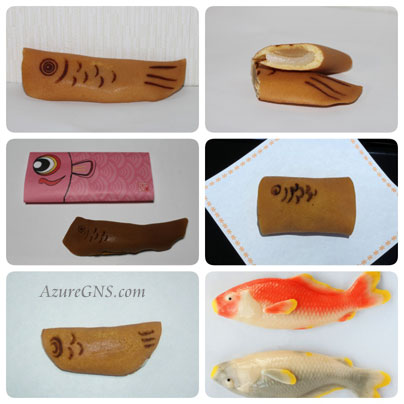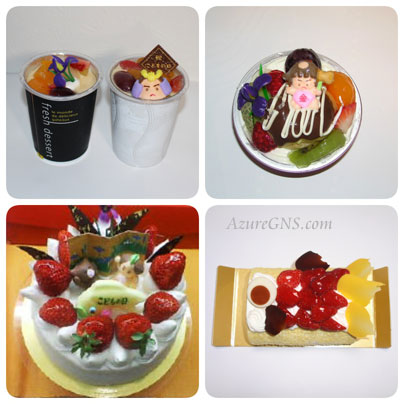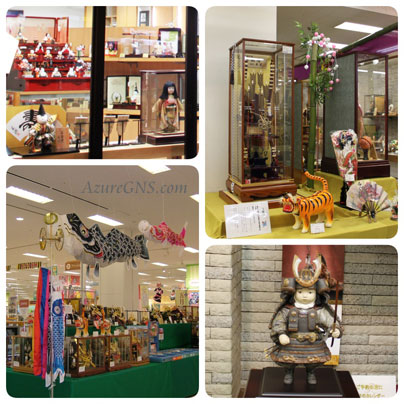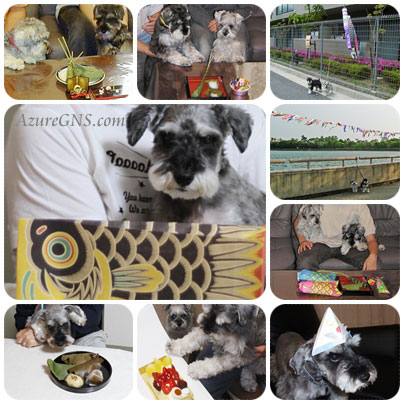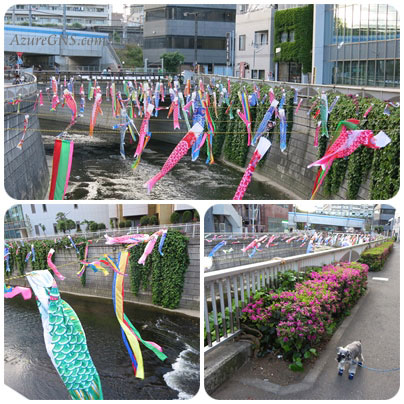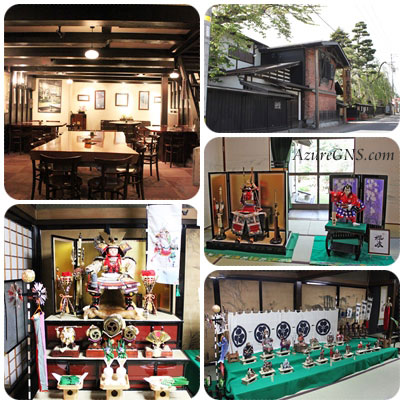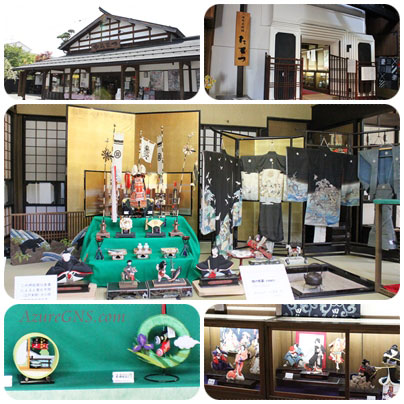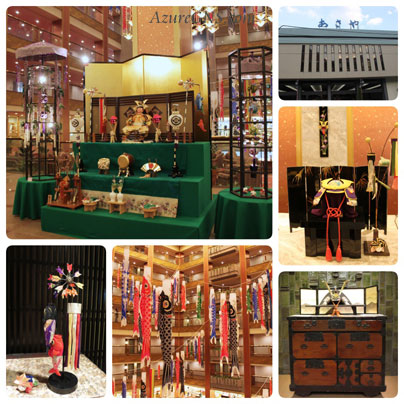Wagaya no Kodomo-no-hi;
Our Children’s Day Experience
5月末に生まれた息子は1歳近くになって初節句を迎えました。祖父母も出席してもらい逞しく、賢く、優しく育つように願いを込めてお祝いをしました。夫の母が作った木目込みの五月人形と、私の両親が贈ってくれた鯉のぼりを飾りました。お赤飯、尾頭付きの鯛、柏餅、ちまきや、息子の好物のお刺身を用意しました。ケーキを作った年もありました。小学校を卒業するとともに五月人形や鯉のぼりは飾らなくなりましたが、お祝いの食事は大人になるまで続けました。
As my son was born at the end of May, he celebrated his Hatsu-zekku (the first Tango-no-sekku or Children’s Day) when he became almost 1 year old. We invited his grandparents and prayed together for his health, wisdom and kindness. We displayed Gogatsu-ningyo (the doll for Children’s day) made by my husband’s father and Koi-nobori (carp-shaped colorful streamers) presented by my parents. I prepared o-sekihan (red rice that Japanese people often eat at celebrations), okashira-tsuki-no-tai (a grilled whole sea bream with its head and tail), chimaki (a steamed rice cake wrapped in a bamboo leaf and bound with rushes), kashiwa-mochi (a rice cake stuffed with anko, sweet bean paste, and wrapped in kashiwa, an oak leaf) and his favorite sashimi (sliced row fish). I sometimes made a cake for him. We decorated Gogatsu-ningyo and Koi-nobori until he graduated from elementary school, but we continued an annual dinner party of Children’s Day until he grew up.
こどもの日が近づくと、子供、特に男子のいる家庭では鯉のぼり(鯉の形をした色鮮やかな吹流しの長い棒につけたもの)を屋外に飾ります。急流を勢いよく登る力強い鯉に、男子の無事生育と立身出世の祈願を託します。一般家庭だけでなく、公共や商業施設でも鯉のぼりを見かけます。東京都渋谷区のこどもの城、東京都千代田区の靖国神社、栃木県日光市の日光江戸村でも鯉のぼりが泳いでいました。
Families, who have children, especially boys, attach Koi-nobori to a tall pole outside their houses when Children’s day is getting close. As carp can swim powerfully up swift-running streams, carp are decorated in the hope of children’s healthy growth and successful life. Koi-nobori are seen not only at ordinary houses but also at public and commercial facilities such as Kodomo-no-shiro in Shibuya Ward, Tokyo Metropolis, Yasukuni Srine in Chiyoda Ward, Tokyo Metropolis and Nikko-Edo-mura (Nikko Edo Wonderland) in Nikko City, Tochigi Prefecture.
毎日の繁雑な仕事や家事に時間をとられ、知らぬ間に時が流れてしまいがちです。そんな日々の中でも、せめて旬のものを口にしたり、自然の中に足を運んだりして、日本の美しい四季の移り変わりを感じながら暮らしていきたいと思っています。我が家は伝統的な年中行事を大切にしています。手の込んだことや豪華なことはなかなかできませんが、こどもの日には小さな装飾品や菖蒲を飾ります。
As I am busy doing complicated work at my office and home every day, time goes by without my noticing. However, I would like to enjoy the alternation of the beautiful seasons in Japan, at least eating seasonal foods and getting close to nature. We respect traditional annual events though it is difficult for us to elaborately or gorgeously celebrate them. On Children’s day, we decorate miniature decorations and irises.
こどもの日には、竹の葉で包まれイ草で縛った蒸し餅のちまきや、餡が入った餅を柏の葉で包んだ柏餅を食べる習慣があります。餡の種類は粒餡、漉餡、白餡、ずんだ餡など様々有ります。地方によって、多種多様なちまき、柏餅、そしてその他の菓子があります。私は柏や竹の葉の青臭い匂いが少し苦手なのであまり食べませんが、家族は好きでよく食べています。
Special Japanese confectionery on Children’s Day are chimaki and kashiwa-mochi. There are some variations in anko: tsubu-an (coarse sweet red bean paste), koshi-an (strained sweet red bean paste), shiro-an (sweet white kidney bean paste) and zunda-an (mashed sweet young broad bean paste). Chimaki, Kashiwa-mochi and other sweets for Children’s Day vary from region to region. My family like both chimaki and Kashiwa-mochi though I don’t like the grassy smell of oak and bamboo leaves.
4月後半になると、こどもの日のための鯉型のお菓子、鯉の袋や鯉が印刷された箱に入ったお菓子が店頭に並びます。可愛らしいお菓子を見つけると、家族に幼い子供がいないのに、つい手を伸ばしてしまいます。長崎県では、「鯉菓子」と呼ばれる、本物の鯉と見紛うような和菓子を食べたり、贈ったりする習慣があるそうです。写真を見せてもらいましたが、あまりにリアルで食べるのに躊躇しそうでした。
Carp-shaped sweets and sweets in carp-shaped bags or boxes for Children’s Day are on sale from the end of April to early May. I just cannot resist buying such cute sweets though no one in our family is at the age of Children’s Day celebration. In Nagasaki Prefecture, there is a custom of eating and sending carp-shaped sweets called “Koi-gashi” (literal translation: carp sweets) which are very realistic to life. When I was shown their photos, I felt they were too real to eat.
こどもの日のお菓子と言えば、定番は柏餅とちまきですが、伝統的なものではありませんが、こどもの日限定ケーキも子供達にはとても人気があります。ケーキはいろいろなバリエーションがあり、菖蒲の花や元気な子供の象徴の金太郎の飾りが施されているものや、鯉の形のものもあります。我が家の息子は柏餅やちまきも好きでしたが、生クリームと苺がたっぷりのケーキも喜んで食べました。
Cakes for Children’s Day are less traditional than Kashiwa-mochi and chimaki, but popular. There are various kinds of cakes. Some are decorated with Kintaro who is the symbol of a healthy child and an iris which is a symbolic flower of the Children’s Day. Others are in a carp-shape. Our son liked a cake covered with a lot of strawberries and whipped cream as well as Kashiwa-mochi and chimaki.
こどもの日には菖蒲湯に入る習慣があり、古くから伝え親しまれています。こどもの日が間近になると、花屋さんで菖蒲湯のための菖蒲の葉を見かけるようになります。菖蒲の葉は、血液循環促進、疲労回復、不眠解消などの薬用効果があります。菖蒲と共に蓬(よもぎ)の葉も一緒に束ねてお風呂に浮かべる地方もあります。菖蒲湯は薬用効果があるだけではなく、邪気を払い、子供が丈夫に育つ縁起の良いお風呂と言われています。菖蒲の葉が手に入らない時は、菖蒲湯の入浴剤を利用することもできます。毎年我が家では、家族全員が菖蒲湯に浸かり、無病息災と邪気浄化を祈ります。
The old custom to take Shobu-yu, a traditional iris-leaf hot bath on Children’s Day, still remains. When Children’s Day is just around the corner, flower shops start to sell iris leaves for Shobu-yu. Iris leaves have some medicinal effects including blood circulation promotion, fatigue recovery and insomnia treatment. In some districts, leaves of yomogi (Japanese mugwort) and iris leaves are floated together on a hot bath for Shobu-yu. Shobu-yu is considered a lucky bath to get rid of evil spirits and make children grow healthy as well as a medicinal bath. Bathing additive of iris leaves can be used as a substitute for fresh iris leaves if they are not available. All my family take Shobu-yu to pray for sound health and the purification of our spirit every year.
3月の女の子のお祭りの雛祭りが終わるとすぐに、デパートやスーパーマーケットではこどもの日のコーナーができます。鯉のぼり、兜の飾り、武者人形などが販売されています。こられを飾る伝統は少しずつ失われていますが、まだ多くの人が孫や息子へプレゼントします。店員さんによると、祖父母はできるだけ大きく豪華なものを買いたがりますが、若い親達はコンパクトのものを好む傾向にあるそうです。
Soon after Hina-matsuri, Girls’ Festival, in March is over, Children’s Day Corners are opened in department stores and supermarkets. Koi-nobori, decorative warrior’s helmets, and warrior dolls are sold there. The tradition of displaying them has been disappearing gradually, but still a lot of people buy them for their grandsons or sons. According to the salesclerks, grandparents tend to prefer a big and gorgeous set of Children’s Day decoration, but young parents tend to prefer a compact one.
我が家の息子はもうとっくに成人してしまったので、「次男」のシュナウザーのおーちゃんのために、毎年こどもの日のお祝いをします。夫がおーちゃんのために折り紙の兜を作って被せてあげましたが、何故かとても不機嫌になり私達を睨みつけました。鯉のぼりを見ながらあちこちを散歩したのも懐かしい思い出です。
As our son has already grown up, we celebrate Children’s Day for our “second son”, a miniature schnauzer called Oh-chan every year. My husband made him a paper warrior’s helmet and put it on him, but he just angrily stared at us. We had a good old memory that we took him for a walk to many places seeing Koi-nobori.
2015年5月に、東京都豊島区高田馬場駅近くの神高橋と高塚橋間で、鯉のぼりイベントが開催されていることをテレビニュースで知り、おーちゃんを連れて家族で出かけました。たくさんの鯉のぼりが神田川上をゆらゆら泳いでいました。前年の10月ふーちゃんが亡くなってちょっと寂しいこどもの日になりました。おーちゃんも高齢になり足腰が弱くなってきたので、鯉のぼりを見ながらゆっくり散歩をしました。
Through a TV news program, I got information about the Koi-nobori event between Kamitaka Bridge and Takatsuka Bridge near Takadanobaba Station in Toshima, Tokyo in May 2015. We decided to go out to see it with Oh-chan. Many Koi-nobori were swaying over the Kanda River. We felt a little lonely because we lost Fu-chan in October of the previous year. As Oh-chan became older, his lower back and legs got weaker, so therefore, we walked slowly together seeing the Koi-nobori.
秋田県仙北市(せんぼくし)の角館(かくのだて) は「みちのくの小京都」と呼ぶにふさわしい風情が漂っています。角館には江戸時代の武家屋敷や豪商の町並が今でも残っています。そんな角館が特に観光客でにぎわうのが、ゴールデンウィーク真只中の桜の季節です。2013年(平成25年)5月初めに、長年憧れていた角館に訪れる機会に恵まれました。醤油と味噌の醸造元の安東商店は創業1853年(嘉永6年)の秋田を代表する老舗です。立派な五月人形や他の装飾品が展示してありました。
Kakunodate in Semboku City, Akita Prefecture deserves to be called “Michinoku-no-Sho-Kyoto” (Little Kyoto in Mutsu Province: “Little Kyoto” is an honorable nickname for towns that resemble Kyoto.) There are still residences of samurai (warrior) and wealthy merchants in Kakunodate which is especially crowded with tourists during Golden Week (from the end of April to the early May), the cherry blossom season. Luckily, I had a chance to visit my long-cherished place, Kakunodate in early May 2013 (Heisei 25th yr). Ando Brewery, established in 1853 (Kaei 6th yr), is one of the most famous brewers of miso (soybean fermented paste) and soy sauce in Akita. Some great sets of Gogatsu-ningyo as well as other decorations were displayed there.
かつての角館城下の武家屋敷通りに面する石黒家は、武家屋敷の中で最も歴史がある建物です。客間など家の一部、蔵、庭などが年中無休で公開されています。驚いたことに、今でも石黒家のご子孫が住んでおられます。多くの貴重な古美術品や武具と共に、五月人形を拝見しました。観光客を楽しませるだけでなく、歴史文化を時代に継承する意味深いものだと思います。
The residence of the Ishiguro Family faces the main street of Buke-yashiki Street of the old town of Kakunodate Castle. It is the oldest building among buke-yashiki (samura residences). A part of the guest room, a storehouse and a garden are open to the public all year round. To my surprise, descendants of the Ishiguros still live there. I saw precious antiques, samurai arms and Gogatsu-ningyo. This is not only an enjoyable event but also a meaningful one which successively inherits historical culture.
たてつ家の現存する建物は1900年(明治33年)に建設されたものです。現在は角館桜皮細工センター(かくのだてかばざいくせんたー)、食堂、土産物店になっています。蔵座敷では、当時の豊かな商家の暮らしぶりを伝える資料が展示されていました。客間には立派な五月人形や男児の着物が展示されていました。雛祭りの季節にはお雛様や女児の着物が展示されるとのことでした。アンティーク着物のレンタルも行われていました。
The existing residences of the Tatetsu Family were built in 1900 (Meiji 33rd yr). Nowadays, they are used as Kakunodate Kabazaiku Center (Kakunodate Cherry-bark Craft Center), a restaurant and a souvenir shop. The historical materials of wealthy merchants’ lives of those days were displayed in kura-zashiki (the room with tatami mats in the storehouse). A gorgeous set of Gogatsu-ningyo and boys’ kimono were exhibited in a guest room. They said that in the Hina-matsuri (the Doll Festival) season, a set of Hina-ningyo (Hina dolls) and girls’ kimono were also displayed. Antique kimono were also available for rent.
栃木県日光市鬼怒川温泉のあさやホテルは、創業130年の格式ある老舗です。大型観光ホテルにもかかわらず、気配りの行き届いたおもてなしが随所に感じられました。子供の日が間近に迫った4月末に訪れたので、広い旅館内のここかしこに端午の節句の装飾が配されていました。ロビーに入ってすぐに、出迎えてくれたのは立派な五月人形の段飾りでした。五月人形の撮影許可をホテルの女性職員に取った際、その前に設置されていたロープスタンドを親切にも撤去して写真を撮りやすくして下さいました。そして、ひときわ目を引いたのが、3階から12階までの吹き抜けに掛けられた多数の鯉のぼりでした。お料理も美味しくて、ブッフェの和洋中100種は、2泊3日の滞在でも全種制覇できませんでした。そして温泉にゆっくり浸かり、日頃の疲れを取りました。
Asaya in Kinugawa-onsen (Kinugawa Hotspring), Nikko City, Tochigi Prefecture is a high-class hotel which celebrated the 130th anniversary of its foundation. This hotel offers hospitality with careful and proper attention to detail in spite of being a large-scale tourist hotel. I visited it at the end of April, several days before Children’s Day, and saw many decorations for Tango-no-sekku (a traditional way to refer to Children’s Day) everywhere in the hotel. The gorgeous Gogatsu-ningyo (literally “May doll”) on the tiered doll-displaying stand was at the entrance of the lobby. I asked a female clerk if I could take photos of it and she was kind enough to allow me to take photos and moved the rope stand in front of the doll stand for me. What attracted me most was so many koi-nobori hanging at an entrance hall with an open ceiling from the 3rd to the 12th floors. I also enjoyed 100 kinds of food: Japanese, Western and Chinese in a buffet style but I could not eat every kind even though I stayed at the hotel for 2 nights and 3 days. I took onsen (a hot-spring bath) to relive everyday fatigue.
(「こどもの日」へ戻ります)
(Back to “Children’s Day”)
Copyright (C) Azure Global Network Services. All Rights Reserved.
